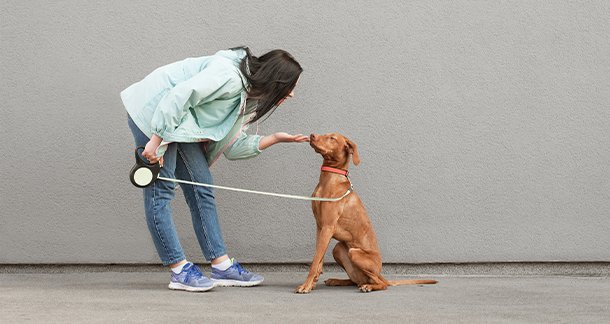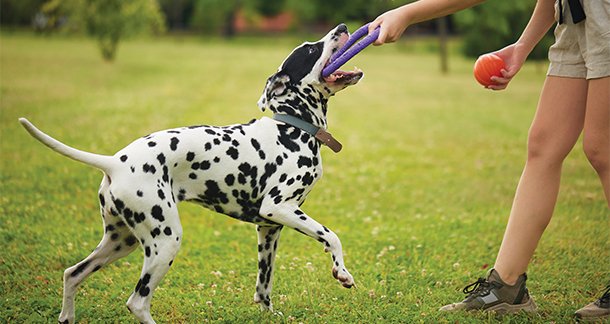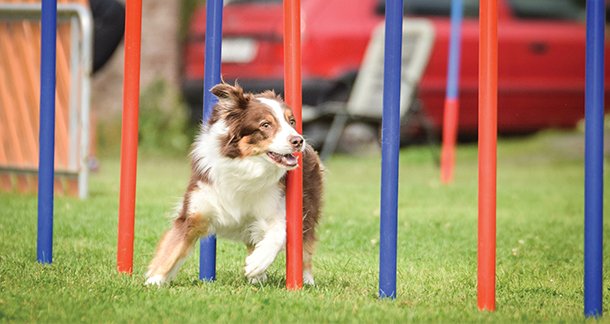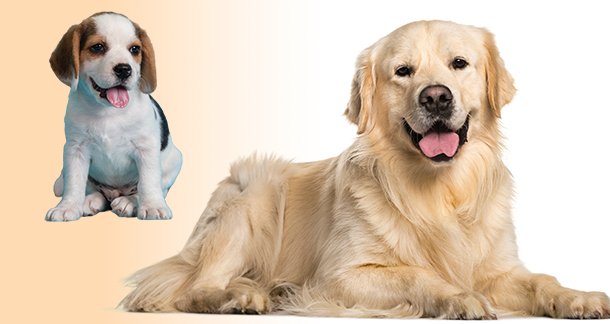adulthood, senior years, and geriatric years — each with distinct developmental and behavioral characteristics. The specific age ranges for these stages can vary based on the dog’s breed and size. While senior years generally begin around 6–7 years of age (earlier for larger breeds), the geriatric stage refers to the later part of a dog’s senior years when signs of advanced aging, such as cognitive decline or frailty, become more pronounced.
Understanding these stages helps dog guardians, caregivers and certified dog trainers provide age-appropriate care, enrichment, and support throughout a dog’s life.
Puppyhood (0–6 months)
What to Expect:
Puppyhood is a critical period of rapid growth and exploration. Puppies are curious, energetic, and learning to make sense of the world around them. Chewing, biting, and potty accidents are common as they try out different behaviors and learn from the responses they get, gradually understanding what is desirable and what isn’t.
Normal Behaviours:
Playful mouthing, nipping, whining, and short attention spans. Puppies explore everything with their mouth and nose, experience frequent naps interrupted by bursts of energy (“zoomies”), and start learning bite inhibition through play and feedback from their mother and littermates. This is why puppies should remain with their mother and siblings until at least 8 weeks of age—to develop essential social skills, and emotional stability.
They also show curiosity but can startle easily, seeking comfort and reassurance from caregivers. During this stage, puppies begin to develop social bonds with humans and other dogs and start recognizing their name and simple cues.
Training Goals:
- Socialization involves gently introducing puppies to a variety of sights, sounds, people, and animals in a safe and controlled environment. This critical period—especially between 4 and 12 weeks of age—is essential for brain development and helps shape their future behavior. Well-socialized puppies grow into confident, adaptable adults who are better prepared to face new experiences without fear.
- Basic cues like sit, stay, drop, leave it, go to bed/place and come here through short, positive sessions.
- Establish house training routines using gentle encouragement.
- Introduce gentle handling to encourage your puppy’s willing participation in grooming and veterinary care, fostering cooperative care that makes these experiences less stressful for both of you.
- Positive reinforcement means encouraging desired behaviors using treats, praise, toys, play—anything your dog finds rewarding— and never resorting to punishment, coercion or the use of aversive tools. This approach is kind, gentle, and builds a strong, trusting bond between you and your dog.

Adolescence (6 months–2 years)
What to Expect:
Adolescence is a time of major hormonal shifts and brain development. As dogs mature physically and emotionally, their behavior may temporarily change. They might appear more distracted, energetic, or inconsistent in responding to cues they previously followed well. This stage can feel unpredictable, but it’s a normal part of growing up.
Normal Behaviours:
You may notice bursts of energy, increased curiosity, a desire for independence, and exploratory behaviors like chewing or digging. Some dogs may seem less responsive to known cues—this is part of how their developing brain processes the world around them.
Training Goals:
- Revisit and strengthen foundational cues like recall, stay, leave it and loose leash walking, especially in more distracting environments.
- Support your adolescent dog through new experiences using calm guidance and rewards to build confidence.
- Provide plenty of physical exercise, enrichment, and problem-solving activities to help them thrive.
- Focus on clear communication and set consistent boundaries using positive reinforcement.
- Teach essential life skills such as calm greetings, settling in various environments, staying home alone for short durations and even the art of doing nothing—helping your dog learn to relax and be okay with stillness.
- Starting early with kind, reward-based training during puppyhood lays a solid foundation that can be incredibly helpful during adolescence. Dogs who have already learned how to learn—through trust, play, and positive associations—are better equipped to navigate this phase successfully.
Adolescence can be a testing phase for guardians, but it’s also an opportunity to deepen your relationship. Patience, empathy, and consistency help your dog build lifelong skills and confidence.
Adulthood (2–6 years)
What to Expect:
By adulthood, dogs generally settle into their personalities, preferences, and energy levels. While they’re often more emotionally balanced than during adolescence, they still need regular mental and physical engagement to stay happy and well-adjusted. This is a great time to deepen your bond and expand your dog’s life skills.
Normal Behaviours:
Adult dogs tend to be more predictable and socially mature. They enjoy play, connection with their humans, and meaningful activities like walks, scent work, or simply relaxing by your side. Their behavior reflects the habits, boundaries, and enrichment they’ve been given up to this point.

Training Goals:
- Make training a part of your everyday life—not a one-time event. Daily interactions offer opportunities to reinforce calm, desirable behaviors.
- Understand and meet your dog’s individual needs.
- Prevent unwanted behaviors by addressing the root causes, which often stem from unmet needs or lack of appropriate outlets.
- Explore enrichment-based training such as scent work, trick training, or agility training to keep your dog engaged and fulfilled.
- Keep sessions fun, low-pressure, and rewarding to maintain your dog’s enthusiasm and willingness to participate.
- Adulthood is when your dog can truly thrive with consistent care, positive communication, and meaningful shared experiences.
Senior Years (6–10+ years, breed-dependent)
What to Expect:
As dogs enter their senior years, you may notice a gradual slowing down in physical activity and energy levels. They might become more sensitive to changes in routine, sounds, or handling, and age-related health issues—such as arthritis, vision or hearing loss—may begin to appear. This is a time for extra gentleness, patience, and thoughtful care.
Normal Behaviours:
Senior dogs may prefer familiar routines, nap more frequently, and engage in shorter, lower-impact activities. They might be less tolerant of overexcitement or changes in their environment. While they may not be as physically active, many still enjoy learning, exploring, and staying socially connected.
Training Goals:
- Adapt activities and expectations to match your dog’s changing physical and cognitive needs.
- Maintain mental sharpness through gentle enrichment like puzzle toys, interactive treat dispenser toys, nose work, and slow-paced training games.
- Continue practicing cooperative care—your dog may need more vet visits or grooming, so making these experiences positive is essential.
- Be mindful of signs of pain or discomfort and avoid any training, outdoor activity that puts physical strain on their body.
- Use familiar cues and consistent routines to provide comfort and confidence.
- Your senior dog still wants to be included, understood, and loved. Training during this stage is less about performance and more about quality of life, trust, and maintaining a strong emotional connection.
Geriatric Years (varies: often 10+ years for small breeds, 7–9+ for large breeds)
What to Expect:
In the geriatric stage, dogs often experience more noticeable signs of aging—such as frailty, mobility challenges, cognitive decline, and sensory loss. They may become more withdrawn or disoriented, and need extra time, support, and understanding to navigate their daily routines.

Normal Behaviours:
Geriatric dogs may sleep more, show signs of confusion or anxiety, and have decreased interest in previous activities. Changes in appetite, toileting habits, and interaction levels are common. Despite physical decline, they often continue to enjoy gentle affection, quiet companionship, and familiar comforts.
Training Goals:
- Focus on maintaining cognitive function through simple, familiar activities, scent-based enrichment, and calm interactive games.
- Stick to predictable routines to help reduce anxiety or confusion.
- Use clear, gentle communication—verbal cues may need to be paired with touch or visual signals if hearing or vision declines.
- Adapt your environment to support mobility and safety—non-slip mats, ramps, or orthopedic beds can make a big difference.
- Practice cooperative care with extra gentleness to help your dog feel safe during grooming or medical procedures.
- Schedule bi-yearly (or more frequent) veterinary check-ups to monitor health and catch age-related issues early.
Above all, this stage is about providing comfort, dignity, and presence. Your dog may not need “training” in the traditional sense, but they do need your patience, consistency, and love more than ever.
Conclusion
Every dog’s journey is unique, and understanding their developmental stages is essential for providing compassionate, age-appropriate care and training. Positive, force-free methods rooted in empathy and science help build trust and confidence at every phase—from curious puppyhood to the tender geriatric years.
Training isn’t just about teaching cues; it’s about building a shared language, nurturing a strong bond, and communicating in ways your dog can understand to thrive in the human world.
Don’t get caught up in what you see on social media—there’s no one-size-fits-all approach to raising a dog. Appreciate the individual in front of you, meet them where they are, and support their growth with patience and respect.
When we honor our dogs’ changing needs and personalities with kindness, we create not just well-behaved dogs—but lifelong companions rooted in trust, joy, and mutual understanding.
ABOUT THE AUTHOR
Ragini Bhandari is a Certified Dog Trainer, Canine Behaviourist, Pet Baker and the founder of Just Pawsible, offering personalised, force-free training for dogs of all ages.

